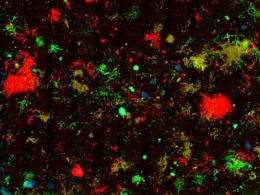Turning back the cellular clock

Cell reprogramming calls The Curious Case of Benjamin Button to mind.
It's a new technology that uses molecular therapy to coax adult cells to revert to an embryonic stem cell-like state, allowing scientists to later re-differentiate these cells into specific types with the potential to treat heart attacks or diseases such as Parkinson's. But at this point in the technology's development, only one percent of cells are successfully being reprogrammed.
Now, for the first time, scientists at Tel Aviv University in collaboration with researchers at Harvard University have succeeded in tracking the progression of these cells through live imaging to learn more about how they are reprogrammed, and how the new cells evolve over time.
Dr. Iftach Nachman of TAU's Department of Biochemistry says that this represents a huge stride forward. It will not only allow researchers to develop techniques and choose the right cells for replacement therapy, increasing the efficiency of cell reprogramming, but will give invaluable insight into how these cells will eventually react in the human body. Results from the research project were recently published in the journal Nature Biotechnology.
Looking at your cell's family tree
Dr. Nachman and his fellow researchers used flourescent markers to develop their live imaging approach. During the reprogramming process, the team was able to visually track whole lineages of a cell population from their single-cell point of origin.
Cell lineage proved to be crucial for predicting how the cells would behave and whether or not they could be reprogrammed successfully, says Dr. Nachman. "By combining quantitative analysis of the data, we were able to see that these 'decisions' are made very early on. We analyzed the cells over time, and we were able to detect subtle changes that occur as early as the first or second day in a long, two-week process."
This is the first time that scientists have looked within a cell population to determine why some cells successfully reprogram while most fail or die along the way. The state in which cells enter the reprogramming process are thought to have an impact on the outcome.
Nature in reverse
Scientists are only beginning to understand this enigmatic process, which reverses nature by causing cells to regress back to their embryonic stage. Increased knowledge of how reprogramming cells proliferate will allow scientists to develop better real-life therapies and reduce risk to patients, says Dr. Nachman.
While embryonic stem cells culled from live embryos can be manipulated to become new "replacement" tissues such as nerve or heart cells, these reprogrammed stem cells from adults represent a safer and ethically more responsible approach, some scientists believe.
The next step for Dr. Nachman and his team is research into specific cell-type characteristics before adult cells even enter the reprogramming process. They will try to discover the molecular markers that differentiate between cells that successfully reprogram and those that do not. Several projects in their lab are now attempting to track different cell types and how they change under live imaging.
Provided by Tel Aviv University
















